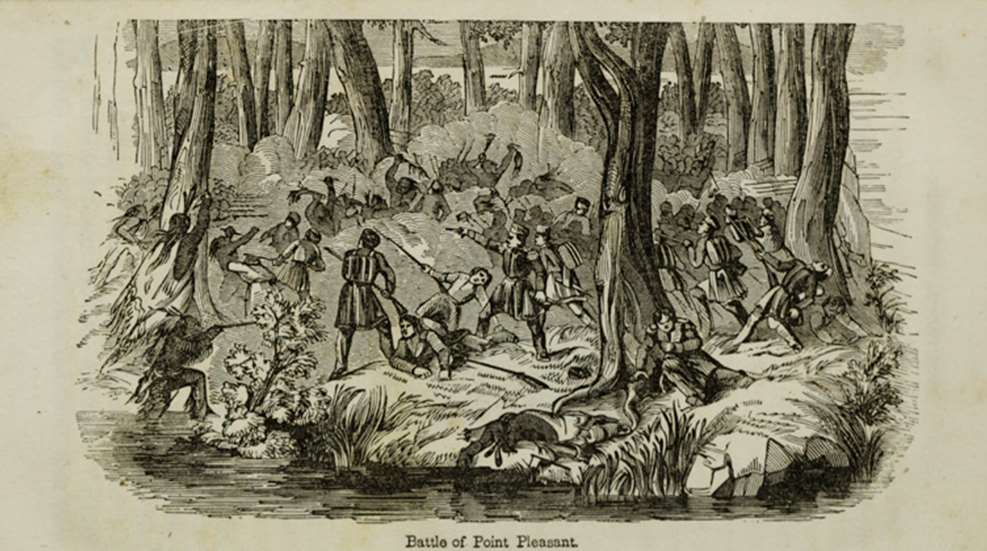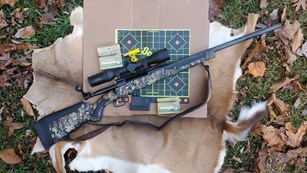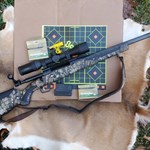
Imagine you’re a young Virginia frontiersman, in your late teens, and the year is 1774. For years you’ve longed to be old enough to join the militia and fight Indians, but now you’re not so sure. You’ve been marching with the army through a vast forest wilderness for some 160 miles, headed northwest to the Ohio country. And all during that time the other soldiers, the veterans, have been telling you stories about Indian fighting; many of the tales so wild you don’t know which ones to believe. But one particular piece of advice sticks in your mind like a burr to a wool sock, “Whatever happens, kid, don’t never let them Injuns take ya alive.”
Now you’re lying along a battle line at dawn, other militiamen on either side, breathing in rapid, shallow breaths, anticipating what’s to come. You’ve never seen an actual Indian before, let alone tried to shoot one, but you’re certain that in just minutes all that will change.
“Make ready, boys!” your sergeant yells. And you check the priming on your flintlock yet one more time. “And don’t no one shoot ‘til I give the word.”
Then, from the deep woods on the other side of the battle line, you hear a high-pitched quavering yell, an ululating scream, an Indian war cry, the first you’ve ever heard—and it’s terrifying! The yell is immediately answered by hundreds of similar Indian voices, only deeper in pitch. And then you see them, dozens of painted warriors running through the woods toward your position, screaming, shouting, zigzagging from tree to tree for cover.
“Fire!” your sergeant yells, and you line up the sights of your musket on a brave not 30 yards away and jerk the trigger. Your fellow militiamen all do the same, and instantly the blackpowder smoke from all the guns firing simultaneously makes seeing the enemy all but impossible. Adrenaline coursing through your body, you load and fire, load and fire, as quickly as you’ve been trained, aiming not at actual Indians now, but rather the muzzle flashes from their guns.
Then the swirling clouds of gun smoke clear for just a few seconds and you see a sight you’ve never before knew even existed. A huge woman warrior, one side of her face painted red, signifying blood, and the other side painted black, signifying death, rises to her full height and gives again that high-pitched ululating scream you’ve been hearing, encouraging the other warriors to attack. The smoke cloud then envelopes her as quickly as it cleared, and you’re certain you’ve seen an image straight from Hell.
That battle, fought October 10, 1774 at the mouth of the Kanawha River where it joins the Ohio River, has come to be known as the Battle of Point Pleasant, the battlefield today encompassed by the small town in West Virginia of the same name. The Shawnee woman warrior fighting in that battle was Nonhelema. She was said to stand a full 6 feet, 6 inches in height, extremely tall for a man in those days—let alone a woman. And she fought just as the men warriors did, stripped to the waist, wearing only a loincloth and moccasins, her body smeared with bear grease to make it difficult for an enemy to grab hold of her in hand-to-hand combat.
Her name in English translates to “Not a man.” The whites called her the Grenadier squaw because of her large size. She was muscular, well proportioned, and handsome if not actually pretty; always carrying herself in a self-assured, almost regal manor. Not many Indian women fought as warriors but there were a rare few, and Nonhelema could fight with the ferocity of any brave.
The fact that she fought at all is surprising, as she was the sister of Cornstalk, the principal peace chief of the Shawnee tribe. Nonhelema was also considered a peacemaker, and was highly respected by both Shawnee men and women. She was the chief of a large Indian village in the Ohio country, known as Nonhelema’s Town, and a leader of the tribe’s Women’s Council.
Shawnee women had just as much influence in tribal affairs as the men, and in some ways more. For instance, if the war chief and warriors voted to go to war against an enemy, they first had to get permission to do so from the Women’s Council. The Shawnees in their wisdom realized that it was the women—the givers of life—who suffered most as a result of war, losing husbands, sons and other male relatives killed in battle. It was a puzzle to Nonhelema all her life why white men did not listen to their women as the Shawnee men listened to theirs.
During the American Revolution, Nonhelema sided with the Americans over the British, believing that the American Long Knives would somehow eventually defeat their white English brothers. It was a long shot at the time, but she did so always with the thought in her mind of what would be best for her people, the Shawnees.
Once, while at Fort Randolph, serving as an interpreter between the whites and Indians, she aided the Americans by disguising two white soldiers to look like Shawnee Indians. A large contingent of Indians, mostly Shawnees, had attacked the fort but was unable to take it and had set up a siege. Nonhelema went outside the walls of the fort, putting herself in danger, and met with the Indian leaders, convincing them to give up their attack and leave. They listened to their peacemaking sister, but during the conversation she overheard where they would be headed next, to white settlements in the east, and she knew those people must be warned before many innocent women and children were killed.
The commander of Fort Randolph, Captain Matthew Arbuckle, chose two soldiers who knew some of the Shawnee language and could possibly pass as Indians. Their mission would be to get word to the American fort near the Greenbrier River that an Indian war party was coming. The problem was that they would have to travel the same trails as the Indian war party. Nonhelema took one look at the pair of soldiers Arbuckle had chosen as couriers and shook her head.
“These two will never pass as Indians,” she said. “I will help.”
Nonhelema instructed the men to shave all the hair from their bodies, leaving only a small patch of hair for a scalp lock at the back of their heads. They were even to pluck out their eyebrows. She then had them darken their skin using black-walnut hulls. She painted their faces with colorful war paint, arranged their bedrolls to hang properly from their shoulders, and sewed the secret messages they’d be carrying into the hems of their blankets.
“One more thing,” she said. “White men walk like ducks. Indians walk pigeon-toed. Walk like an Indian along the trail, and even if you leave tracks the warriors will not suspect you.” The two men did and made it through.
Another incident involving Nonhelema did not go so well. Her brother, Cornstalk, had brought his son Elinipsico to the fort, as well as two other warriors, Red Hawk and Patella, also known as Old Yie. The four had come in peace, but Captain Arbuckle ordered them held against their will. While in captivity at the fort, militiamen broke into the room where the Indians were being housed and murdered all four of them in cold blood.
Nonhelema was not hurt in the attack, but was understandably enraged that her brother Cornstalk—the principal peace chief of the Shawnees—and the others had been killed, slaughtered like cattle. She demanded that Captain Arbuckle turn over the murderers to the Shawnee tribe for retribution. Arbuckle refused, but promised Nonhelema that the men would be taken back to Virginia and tried under a white men’s court of law.
“If they are not found guilty and executed for my brother’s death, a forest will fall on you,” she predicted, pointing her finger at him. Arbuckle asked Nonhelema what she meant by that and she admitted she didn’t know for sure, but had seen it in a vision. Indians put great stock in dreams and visions and how they could affect the future.
Months later, when Arbuckle returned to the fort from taking the militiamen back to Virginia for trial, Nonhelema confronted him. “Has my brother’s death been avenged?” she asked. “No…,” Arbuckle said, avoiding her eyes. “The men were acquitted.”
And several years later, when Captain Matthew Arbuckle was riding through a forest on a horse on a windy day, the top of a large tree toppled over, fell on him and killed him. Nonhelema faded from history over the ensuing years. It is not known for sure where, when, or how the peacemaking warrior woman of the Shawnees eventually died.




































